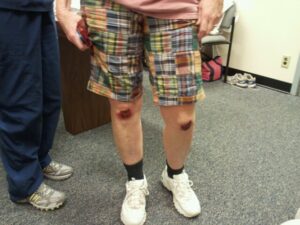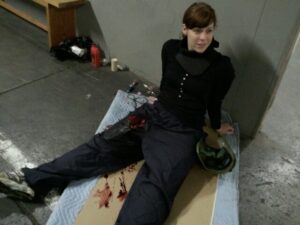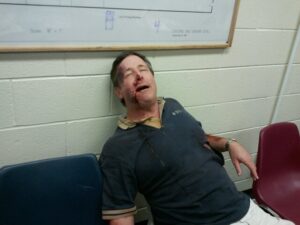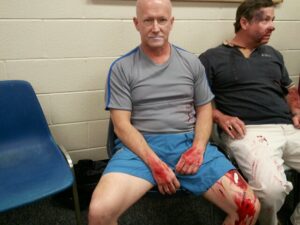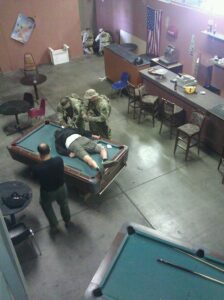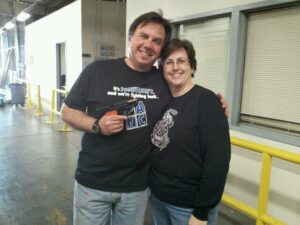On Tuesday, I spent the day with several SWAT teams as they went through medic training with the FBI.
🙂
SWAT–Special Weapons and Tactics- operatives specialize in hostage situations, high-risk warrant service operations, search-and-rescue operations, covert and undercover tactical operations and crowd control. Team members must complete advanced training and, while it is different from department to department, it’s rigorous and they must re-qualify continually. In the FBI, SWAT members must qualify monthly at the gun range, for example. But it’s not only firearms training–the physical training is just as demanding.
SWAT teams know how to be cops–they can take out the bad guys and secure a scene–but what about the victims? Until the paramedics arrive, SWAT is in charge–after they neutralize the danger, they need to assess injuries, give first aid, and maintain control. The victims are their patients. These guys already have experience with advanced first aid. Many are former military, and all have extensive experience–as Toni can explain better than I, to make a SWAT team requires not only a wide-range of abilities, but being the BEST at it. You can’t just make the SWAT team and coast–you are constantly tested and need to re-qualify every month.
This was the third role playing day I’ve done with the FBI, and the second that focused on triage. There were six stations the teams rotated through, including a hostage situation, a domestic situation, traffic stop gone bad, and an active shooter in a school environment. However, this time trauma surgeons and paramedics volunteered their time and expertise–at their own expense–traveling from as far as Virginia and San Diego because they are so passionate about their job and believe fully in these types of training programs.
The training sessions, which are put on by the FBI and offered to local law enforcement throughout the area, are multi-day events. On Monday, the SWAT teams–some which traveled over 150 miles to participate–took classes from the medical personnel. And on Tuesday, they put what they learned to the test.
They all know it’s not real, but a team of UC Davis trauma nurses came out to make it as real as possible, with “moulage.” Moulage is the art of applying mock injuries in training ERT’s and other medical or military personnel. Moulage is applying pre-made rubber or latex “wounds” and often uses makeup for realism (such as blood, open fractures, gunshot wounds, etc.)
The injuries could be minor:
Or life-threatening:
Heather above had a deep stab wound in her thigh. The medic set her up with an IV of blood attached to the rubber wound so that she could make it bleed when the SWAT team arrived. It was kind of cool 🙂 Her wound was used to teach a technique about packing with a tourniquet would be difficult or impossible to place–packing gauze deep into a gaping wound to cover as much surface area as possible to help with the clotting process.
Some of the wounds looked incredibly realistic. Such as Tom’s blunt force trauma:
or this re-barb injury:
or Stan’s gunshot wound:
or my own “injury” — a protruding bone that I got from running and falling down the stairs when the shooting started.

In my scenario, there were two shooters in a school or workplace situation. SWAT came in, neutralized the suspects quickly, then tended to the victims while waiting for the helicopter and EMTs to arrive. The purpose is to, essentially, secure the scene and triage the victims–assess their injuries, perform emergency first aid (i.e. applying tourniquets, giving CPR, etc.) and prioritize for transport. Easy? Not really. As role players, we acted like victims. Once we were on–and there was simulated gun fire using paint pellets with a primer so it sounds close to a real gun–your heart races. The SWAT team comes through–and each team does it differently–to secure the site and take out the shooters. In a real situation, they’d have people running at them, or reaching for them to help, or calling over to them. There are screams and cries and they don’t know who the shooter is, often where he is, if there is a partner, how many–they have to go in assuming that everyone is a suspect. We’re not supposed to make it easy for them, because in the real world they’re going to encounter a wide variety of victims. Screaming. Hysterical. Crying. Helpful. Calm. Shock.
They need to ignore the victims while they take care of the shooters, secure the building, then tend to the victims. One thing the paramedic in my scenario suggested (and praised) was bring the victims together to share limited supplies, keep them in sight, and make them easier to treat and transport. Another point driven home: SWAT was in charge of the victims, not just the crime scene, until medical help arrived. They needed to treat us victims, talk to us, calm us down. Some of the teams were better than the others at small talk. Others were straight business.
For my part, I had a non-life threatening but extremely painful broken leg with a protruding bone. And it was bleeding pretty darn good as well. I screamed when the gunfire started, then cried, sobbing, and depending on my mood during that drill, I would either beg for someone to help me or demand to know what happened to my friend Heather (the stabbing victim.) Kathy was part of the “walking wounded” — scrapped knees and a gunshot to the arm. She was great that when she saw the SWAT guys she’d stagger over to them. I could totally see that happening in real life. (I mean, if there WAS a shooter, I would definitely want to be as close to the cops as possible! Or I’d hide. 🙂 )
We’re supposed to stay in role until the instructor calls for the team to come together. One SWAT team–which was tactically the most aggressive–quickly assessed everyone, applied the tourniquet to my leg, and then left me (as well as the other victims.) I couldn’t see what they were doing, but if I were being left without comment, I would probably want to know what the heck they were doing leaving me alone with a dead body as company. So they walk off and I called out, “Wait! Don’t leave me! I want to go home! Where are you? Please come back!” The head paramedic liked my improv 🙂
Near the end, the “helicopter” arrives and the SWAT leader is required to give a rundown of victims and injuries quickly and accurately. Then, the medic asks, “I have room for three. Who goes now?” And they need to know. If they don’t, the medic loses confidence that they’ve done the proper triage.
One of my favorite parts of the role playing drills is when the instructor walks through the scene and assesses the teams strengths and identifies areas of improvement. I say it that way because none of these SWAT teams were weak. This is where I learn the most–the little details that help me understand my characters and what they may face–both as a victim and as a hero. The facts and stats are always good to know, but it’s the reasoning behind decisions, the human factor of being a cop or a victim, that makes my books real to me, and I hope to my readers.
I talked to some of the guys afterward. Because everyone knows this isn’t real, I wanted to get their impression of the effectiveness of these types of drills. Of the three cops I spoke with, they were all enthusiastic about the program. One guy said that even though they know it’s not real, as soon as they’re geared up begin, the adrenaline starts pumping. Having role players with realistic injuries and playing a part makes it more real, and helps them focus on the situation. Everyone had praise for the medical experts who came out–on their own dime–to run the SWAT/medic training program. Some had never been in a program like this; others had participated before.
And all of them–from the SWAT operatives to the trauma surgeons to the paramedics to the FBI instructors who ran the program and assisted in the drills–are truly the everyday heroes I like to write about.
I can’t wait to do another drill. This was my third role-playing scenario. I’ve also toured Quantico (and plan to go back later this year), toured the morgue and observed an autopsy, and toured Folsom prison (and was warned that they don’t negotiate–so please don’t be taken hostage.) And more–I have been both lucky and blessed to be able to do a lot of these research “trips”–because while I love reading and learning from books, there’s nothing like going on-scene. I haven’t done a ride-along yet, but it’s high up on my list.
One of the other drills was a barroom hostage situation–the suspect stabbed his girlfriend and had a gun on her. He shoots at the cops when they come in, then is gunned down. So the scenario is designed to deal with both an officer down and life-threatening injuries to a hostage. Here’s a shot from the catwalk of that scenario:
And here is me with Joe Getty, from the morning radio program Armstrong and Getty. I did another scenario with Joe–when he was a bad guy and I was the wife of a wanted sex offender. On that day, we were both handcuffed and decided that being cuffed wasn’t fun!
My question for you all whether or not you’re a writer, what’s the one “research trip” you’d be excited about? Role playing with SWAT? A ride-along with local cops? Firefighters? A tour of the morgue? A prison? A military base? What about flying a plane with a fighter pilot, learning to parachute, or touring the underground tunnels in Sacramento? Shadowing a judge? A prosecutor? It can be anything, just something you’ve always wanted to learn about outside of your normal profession or hobbies. Comment for a chance to win a $25 gift certificate to the online bookstore of your choice!
On a more personal note, thank you to everyone who helped put KISS ME, KILL ME on the NYT list (#16) and the USAT list (#32)! I’m now deep into writing IF I SHOULD DIE, which is scheduled to be released on 11.22.11. And I’m giving you all a sneak peak at the new cover . . . which looks so good with the first two Lucy books.

